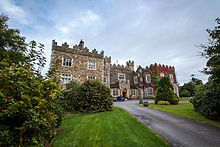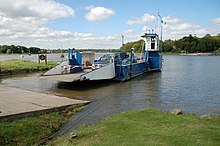
Irish round towers are early mediaeval stone towers of a type found mainly in Ireland, with two in Scotland and one on the Isle of Man. As their name Cloigtheach indicates, they were originally bell towers, though they may have been later used for additional purposes.

A battlement, in defensive architecture, such as that of city walls or castles, comprises a parapet, in which gaps or indentations, which are often rectangular, occur at intervals to allow for the launch of arrows or other projectiles from within the defences. These gaps are termed embrasures, also known as crenels or crenelles, and a wall or building with them is described as crenellated; alternative older terms are castellated and embattled. The act of adding crenels to a previously unbroken parapet is termed crenellation.

Craggaunowen is an archaeological open-air museum in eastern County Clare, Ireland. It is named for the 16th-century castle which is one of its main components.

Roscrea is a market town in County Tipperary, Ireland, which in 2016 had a population of 5,446. Roscrea is one of the oldest towns in Ireland, having developed around the 7th century monastery of Saint Crónán of Roscrea, parts of which remain preserved today.

Castlemartyr is a large village in County Cork, Ireland. It is around 30 kilometres (19 mi) east of Cork city, 10 km (6 mi) east of Midleton, 16 km (10 mi) west of Youghal and 6 km (4 mi) from the coast. Approximately 1,600 people live in the village and its hinterland. It is situated on the N25 national primary road and the R632 regional road.
The architecture of Ireland is one of the most visible features in the Irish countryside – with remains from all eras since the Stone Age abounding. Ireland is famous for its ruined and intact Norman and Anglo-Irish castles, small whitewashed thatched cottages and Georgian urban buildings. What are unaccountably somewhat less famous are the still complete Palladian and Rococo country houses which can be favourably compared to anything similar in northern Europe, and the country's many Gothic and neo-Gothic cathedrals and buildings.
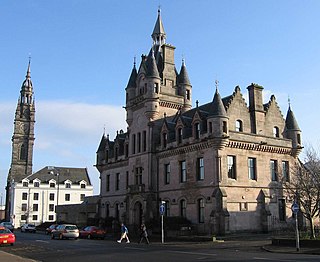
Scottish baronial or Scots baronial is an architectural style of 19th-century Gothic Revival which revived the forms and ornaments of historical architecture of Scotland in the Late Middle Ages and the Early Modern Period. Reminiscent of Scottish castles, buildings in the Scots baronial style are characterised by elaborate rooflines embellished with conical roofs, tourelles, and battlements with machicolations, often with an asymmetric plan. Popular during the fashion for Romanticism and the Picturesque, Scots baronial architecture was equivalent to the Jacobethan Revival of 19th-century England, and likewise revived the Late Gothic appearance of the fortified domestic architecture of the elites in the Late Middle Ages and the architecture of the Jacobean era.
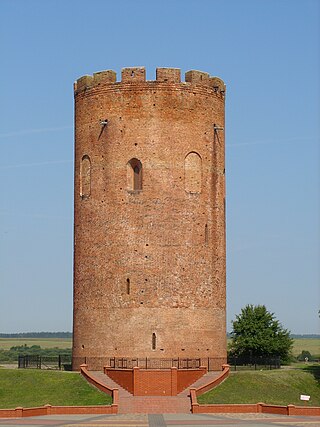
The Tower of Kamyenyets, also called the White Tower, is the main landmark of the town of Kamyenyets in Belarus. The name Bielaja Vieža, which literally means White Tower or White Fortress in Belarusian, presumably derives from the tower's proximity to the Belavezhskaya Pushcha Forest, but not from its color, which has been brick-red through the ages, never white.

Cappoquin, also sometimes spelt Cappaquin, is a town in western County Waterford, Ireland. It is on the Blackwater river at the junction of the N72 national secondary road and the R669 regional road. It is positioned on a sharp 90-degree bend in the river and lies at the foot of the Knockmealdown Mountains. The town is a few miles from Mount Melleray and Lismore, County Waterford.
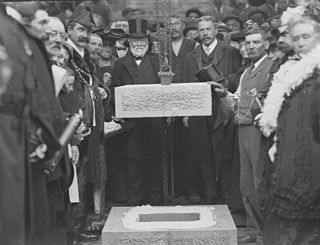
Waterford City Library, also known as the Central Library, is a public library in Waterford, Ireland. It was the first to be built of Ireland's many Carnegie libraries. The philanthropist Andrew Carnegie, who had previously opened libraries in Scotland and the US, himself laid the foundation stone in 1903.
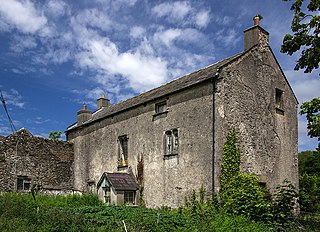
Ballygunner Castle is a country house in the Ballygunner area of County Waterford in Ireland. It is believed to be built on the site of a former Viking stronghold. The main structure of the house includes a combination of medieval and 17th century building, with evidence of further modifications in the 18th and 19th centuries.

Moorstown Castle is a late 15th-century stone structure consisting of an enclosed circular keep near Clonmel, County Tipperary, Ireland.
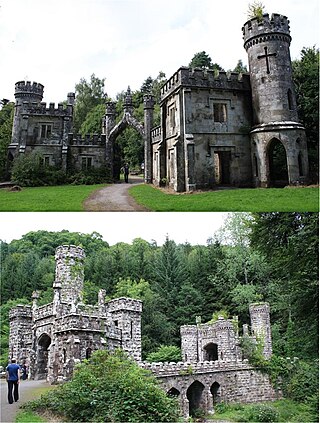
Ballysaggartmore Towers are two ornate entrance lodges that are situated on the former Ballysaggartmore Demesne approx 2.5 kilometres from the town of Lismore in County Waterford, Ireland. The structures are considered architectural "follies".

Dripsey Castle is a country house in the townland of Carrignamuck, situated 3.3 km (2.1 mi) north-east of Coachford village and 2.5 km (1.6 mi) north-west of Dripsey village. The house and demesne were dominant features in the rural landscape of Ireland, throughout the eighteenth and nineteenth centuries. Location often reflected the distribution of better land, and this is evidenced in mid-Cork, where many of these houses are situated along the valley of the River Lee and its tributaries.
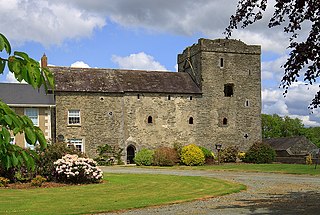
Athclare Castle is a Tudor tower house in the Dunleer area of County Louth in Ireland. Built in the 1550s, Athclare was built for the Barnewell family, and is typical of defensive architectural structures built in the Pale during the Tudor period in Ireland. Athclare has been extended and adapted in the centuries since its construction and is classified as a site of National social historical importance by the Irish National Inventory of Architectural Heritage.
Woodhouse is a Georgian mansion and c. 500-acre estate just outside the village of Stradbally, County Waterford, Ireland.

Cappoquin House also known as Belmont is an 18th-century classical-style mansion overlooking the town of Cappoquin in County Waterford, Ireland. The house is the seat of the Keane Baronets of Belmont and of Cappoquin.

Gurteen de la Poer, or Gurteen le Poer, is an Elizabethan Revival house in County Waterford, Ireland, situated on the south bank of the River Suir, close to Kilsheelan and about 8 km east of Clonmel.

Roscrea Castle is a 13th-century motte-and-bailey castle in the town of Roscrea, Ireland. The Castle consists of a walled courtyard, gate block, and angled towers. Along with 18th century Damer House and gardens, the Castle forms part of Roscrea Heritage Centre.

William Robertson, an Irish architect, was born in Kilkenny, Ireland, some days before 4 December 1770. He attended the Dublin Society where he was awarded with a silver medal for his drawing skills in 1795.

